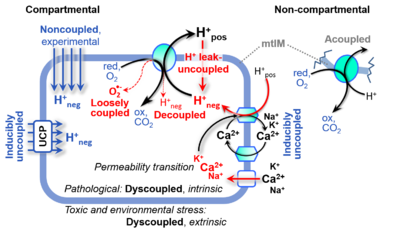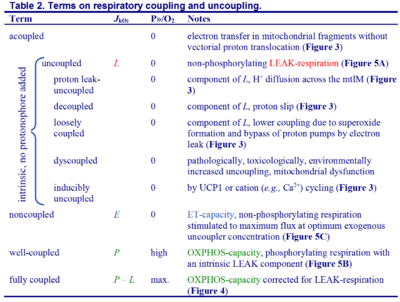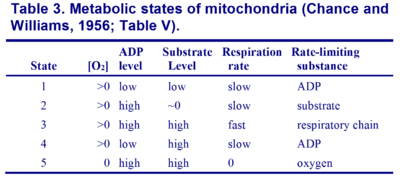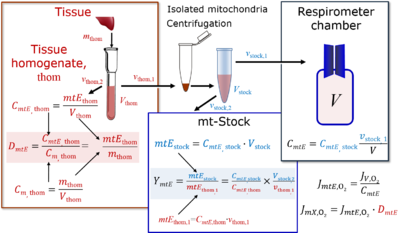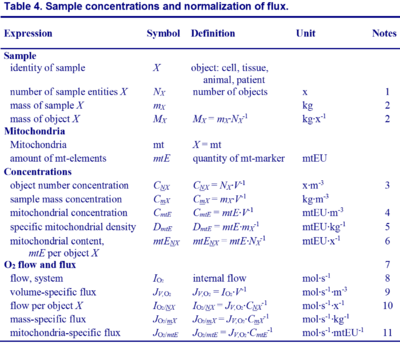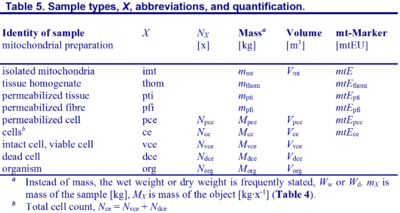| News and Events | Working Groups | Short-Term Scientific Missions | Management Committee | Members |
COST Action CA15203 (2016-2021): MitoEAGLE
Evolution-Age-Gender-Lifestyle-Environment: mitochondrial fitness mapping
Gnaiger 2019 MitoFit Preprints
| MitoEAGLE preprint 2018-02-10(23) Mitochondrial respiratory states and rates: Building blocks of mitochondrial physiology
Part 1. - http://www.mitoeagle.org/index.php/MitoEAGLE_preprint_2018-02-08. |
» Last update 2018-02-10:  - » Versions
- » Versions
Corresponding author:, Gnaiger E, Contributing co-authors:, Ahn B, Alves MG, Amati F, Aral C, Arandarcikaite O, Asander Frostner E, Bailey DM, Bastos Sant'Anna Silva AC, Battino M, Beard DA, Ben-Shachar D, Bishop D, Breton S, Brown GC, Brown RA, Buettner GR, Calabria E, Cardoso LHD, Carvalho E, Casado Pinna M, Cervinkova Z, Chang SC, Chicco AJ, Chinopoulos C, Coen PM, Collins JL, Crisostomo L, Davis MS, Dias T, Distefano G, Doerrier C, Drahota Z, Duchen MR, Ehinger J, Elmer E, Endlicher R, Fell DA, Ferko M, Ferreira JCB, Filipovska A, Fisar Z, Fisher J, Garcia-Roves PM, Garcia-Souza LF, Genova ML, Gonzalo H, Goodpaster BH, Gorr TA, Grefte S, Han J, Harrison DK, Hellgren KT, Hernansanz P, Holland O, Hoppel CL, Houstek J, Hunger M, Iglesias-Gonzalez J, Irving BA, Iyer S, Jackson CB, Jansen-Duerr P, Jespersen NR, Jha RK, Kaambre T, Kane DA, Kappler L, Karabatsiakis A, Keijer J, Keppner G, Komlodi T, Kopitar-Jerala N, Krako Jakovljevic N, Kuang J, Kucera O, Labieniec-Watala M, Lai N, Laner V, Larsen TS, Lee HK, Lemieux H, Lerfall J, Lucchinetti E, MacMillan-Crow LA, Makrecka-Kuka M, Meszaros AT, Michalak S, Moisoi N, Molina AJA, Montaigne D, Moore AL, Mracek T, Muntane J, Muntean DM, Murray AJ, Nedergaard J, Nemec M, Newsom S, Nozickova K, O'Gorman D, Oliveira PF, Oliveira PJ, Orynbayeva Z, Pak YK, Palmeira CM, Patel HH, Pecina P, Pereira da Silva Grilo da Silva F, Pesta D, Petit PX, Pichaud N, Pirkmajer S, Porter RK, Pranger F, Prochownik EV, Puurand M, Radenkovic F, Reboredo P, Renner-Sattler K, Robinson MM, Rohlena J, Roesland GV, Rossiter HB, Rybacka-Mossakowska J, Salvadego D, Scatena R, Schartner M, Scheibye-Knudsen M, Schilling JM, Schlattner U, Schoenfeld P, Scott GR, Shabalina IG, Shevchuk I, Siewiera K, Singer D, Sobotka O, Spinazzi M, Stankova P, Stier A, Stocker R, Sumbalova Z, Suravajhala P, Tanaka M, Tandler B, Tepp K, Tomar D, Towheed A, Tretter L, Trivigno C, Tronstad KJ, Trougakos IP, Tyrrell DJ, Urban T, Velika B, Vendelin M, Vercesi AE, Victor VM, Villena JA, Wagner BA, Ward ML, Watala C, Wei YH, Wieckowski MR, Wohlwend M, Wolff J, Wuest RCI, Zaugg K, Zaugg M, Zorzano A, Supporting co-authors:, Bakker BM, Bernardi P, Boetker HE, Borsheim E, Borutaite V, Bouitbir J, Calbet JA, Calzia E, Chaurasia B, Clementi E, Coker RH, Collin A, Das AM, De Palma C, Dubouchaud H, Durham WJ, Dyrstad SE, Engin AB, Fornaro M, Gan Z, Garlid KD, Garten A, Genova ML, Gourlay CW, Granata C, Haas CB, Haavik J, Haendeler J, Hand SC, Hepple RT, Hickey AJ, Hoel F, Jang DH, Kainulainen H, Khamoui AV, Klingenspor M, Koopman WJH, Kowaltowski AJ, Krajcova A, Lane N, Lenaz G, Malik A, Markova M, Mazat JP, Menze MA, Methner A, Neuzil J, Oliveira MT, Pallotta ML, Parajuli N, Pettersen IKN, Porter C, Pulinilkunnil T, Ropelle ER, Salin K, Sandi C, Sazanov LA, Silber AM, Skolik R, Smenes BT, Soares FAA, Sokolova I, Sonkar VK, Swerdlow RH, Szabo I, Trifunovic A, Thyfault JP, Valentine JM, Vieyra A, Votion DM, Williams C, Zischka H (2017) MitoEAGLE preprint
Abstract: As the knowledge base and importance of mitochondrial physiology to human health expand, the necessity for harmonizing nomenclature concerning mitochondrial respiratory states and rates has become increasingly apparent. Clarity of concept and consistency of nomenclature are key trademarks of a research field. These trademarks facilitate effective transdisciplinary communication, education, and ultimately further discovery. Peter Mitchell’s chemiosmotic theory establishes the link between vectorial and scalar energy transformation and coupling in oxidative phosphorylation. The unifying concept of the protonmotive force provides the framework for developing a consistent theory and nomenclature for mitochondrial physiology and bioenergetics. Herein, we follow IUPAC guidelines on general terms of physical chemistry, extended by considerations on open systems and irreversible thermodynamics. We align the nomenclature and symbols of classical bioenergetics with a concept-driven constructive terminology to express the meaning of each quantity clearly and consistently. In this position statement, in the frame of COST Action MitoEAGLE, we endeavour to provide a balanced view on mitochondrial respiratory control and a critical discussion on reporting data of mitochondrial respiration in terms of metabolic flows and fluxes. Uniform standards for evaluation of respiratory states and rates will ultimately support the development of databases of mitochondrial respiratory function in species, tissues, and cells. • Keywords: Mitochondrial respiratory control, coupling control, mitochondrial preparations, protonmotive force, oxidative phosphorylation, OXPHOS, electron transfer, ET; proton leak, LEAK, residual oxygen consumption, ROX, State 2, State 3, State 4, normalization, flow, flux • Bioblast editor: Gnaiger E
Letter to the Editors of scientific journals
- Dear Editors:
- We would like to ask you for your opinion about the increasingly urgent issue of nomenclature in mitochondrial physiology. With your collaboration we can contribute to making publications with data on mitochondrial respiration more generally comprehensible and improve a more uniform standard in the field.
- As the knowledge base and importance of mitochondrial physiology to human health expand, the necessity for harmonizing nomenclature concerning mitochondrial respiratory states and rates has become increasingly apparent. In the frame of COST Action MitoEAGLE, we endeavour to provide a balanced view on mitochondrial respiratory control and a critical discussion on reporting data of mitochondrial respiration. Uniform standards for evaluation of respiratory states and rates will ultimately support the development of databases of mitochondrial respiratory function in species, tissues, and cells.
- A Working Group of the COST Action MitoEAGLE prepares a document on ‘Mitochondrial respiratory states and rates’, with Open Access as a ‘MitoEAGLE preprint’ and the ultimate aim of publication in a scientific journal:
- pdf preprint: » http://www.mitoeagle.org/index.php/MitoEAGLE_preprint_2018-02-08
- Executive summary: » http://www.mitoeagle.org/index.php/MitoEAGLE_preprint_2018-02-08#Executive_summary
- A Working Group of the COST Action MitoEAGLE prepares a document on ‘Mitochondrial respiratory states and rates’, with Open Access as a ‘MitoEAGLE preprint’ and the ultimate aim of publication in a scientific journal:
- We would like to include your opinion as editor. We aim at providing a list of journals, from whom we received valuable feedback:
- Do you recognize a general need for a consensus on nomenclature and standards of reporting in the field of mitochondrial respiratory physiology?
- Can you provide comments and suggestions for the MitoEAGLE preprint: 'Mitochondrial respiratory states and rates’ from your point of view as an editor?
- Which further steps do you suggest towards implementing a harmonized terminology on mitochondrial states and rates in your editorial policy?
- We would like to include your opinion as editor. We aim at providing a list of journals, from whom we received valuable feedback:
- I thank you for your considerations.
- With kind regards,
- Erich Gnaiger, Ao.Univ.-Prof., Ph.D.
- Chair COST Action CA15203 MitoEAGLE - http://www.mitoeagle.org
- Chair Mitochondrial Physiology Society - http://www.mitophysiology.org
- Medical University of Innsbruck
- Department of Visceral, Transplant and Thoracic Surgery
- D. Swarovski Research Laboratory
- A-6020 Innsbruck, Austria
- Email: mitoeagle@i-med.ac.at
Executive summary
Updated 2018-02-11

- In view of broad implications on health care, mitochondrial researchers face an increasing responsibility to disseminate their fundamental knowledge and novel discoveries to a wide range of stakeholders and scientists beyond the group of specialists. This requires implementation of a commonly accepted terminology within the discipline and standardization in the translational context. Authors, reviewers, journal editors, and lecturers are challenged to collaborate with the aim to harmonize the nomenclature in the growing field of mitochondrial physiology and bioenergetics.
- Aerobic energy metabolism in mammalian mitochondria depends on the coupling of ADP → ATP phosphorylation to catabolic reactions involving oxygen consumption. This is the process of oxidative phosphorylation, in which coupling is mediated by translocation of protons through respiratory proton pumps operating across the inner mitochondrial membrane and generating or utilizing the protonmotive force measured between the mitochondrial matrix and intermembrane compartment. Compartmental—or vectorial—coupling thus distinguishes respiration from fermentation as the counterpart of cellular core energy metabolism.
- Extra-mitochondrial concentrations—of fuel metabolites transported into the matrix, ADP, ATP, inorganic phosphate, and cations including pH—can be separated from cytosolic interactions with fermentation and be experimentally controlled only after disrupting the barrier function of the plasma membrane. Measurement of respiration under such controlled conditions, therefore, depend on mitochondrial preparations—including isolated mitochondria, tissue and cellular preparations—in which the plasma membrane is selectively removed or permeabilized while the structural and functional integrity of the mitochondria is maintained. Mitochondrial respiratory capacities quantify the upper bound of the rate of respiration measured under a set of conditions defined as coupling control states. A concept-driven terminology of bioenergetics incorporates in its terms and symbols explicitly information on the nature of respiratory states. Then the technical terms are readily recognized; they are defined with normal words that makes them easy to understand.
- Mitochondrial coupling states are defined according to the control of respiratory oxygen consumption by the protonmotive force. Capacities of oxidative phosphorylation and electron transfer capacities provide reference values of mitochondrial function as required for the diagnosis of health and disease, and for evaluation of the effects of Evolutionary background, Age, Gender and sex, Lifestyle and Environment (EAGLE).
- Some degree of uncoupling is a characteristic of energy-transformations across membranes. Uncoupling is caused by a variety of physiological, pathological, toxicological, pharmacological and environmental conditions that exert an influence not only on the proton leak and cation cycling, but also on proton slip within the proton pumps and the structural integrity of the mitochondria. A more loosely coupled state is induced by stimulation of mitochondrial superoxide anion radical formation and the bypass of proton pumps. In addition, uncoupling by application of protonophores represents an experimental intervention for the transition from a well-coupled to the noncoupled state of mitochondrial respiration.
- Respiratory oxygen consumption rates have to be carefully normalized to provide valid information and enable meta-analytic studies beyond the specific question of a particular experiment. Therefore, all raw data should be published in a supplemental table or open access data repository. Normalization of rates for the volume of the experimental chamber (the measuring system) is distinguished from normalization for (1) the volume or mass of the experimental sample, (2) the number of objects (cells, organisms), and (3) the concentration of mitochondrial markers in the chamber.
- The consistent use of terms and symbols discussed in this MitoEAGLE position statement will facilitate transdisciplinary communication and support further developments of a database on bioenergetics and mitochondrial physiology. The present recommendations on coupling control states and rates are focused on studies with mitochondrial preparations. These will be extended in a series of reports on pathway control of mitochondrial respiration, respiratory states in intact cells, and harmonization of experimental procedures.
Concept
- Citation:
- MitoEAGLE preprint 2018-02-08(Version #). Mitochondrial respiratory states and rates: Building blocks of mitochondrial physiology Part 1. - http://www.mitoeagle.org/index.php/MitoEAGLE_preprint_2018-02-08
Authors
- Contributing co-authors: Confirming to have read the final manuscript, possibly to have made additions or suggestions for improvement, and to agree to implement the recommendations into future manuscripts, presentations and teaching materials. (alphabetical, to be extended)
- Supporting co-authors: Confirming to have read the final manuscript, and to agree to implement the recommendations into future manuscripts, presentations and teaching materials. (alphabetical, to be extended)
Concept and discussion: COST Action MitoEAGLE
- Phase 1: 44 versions until 2017-09-18 / Discussion
- Phase 2 21 versions until 2018-02-06 / Discussion
- (2017-09-21 ongoing): MitoEAGLE preprint - with updates on route to let the final publication fly.
- MiP2017/MitoEAGLE Hradec Kralove CZ - Discussion of manuscript submission for journal publication.
- Phase 3: (2018-02-08 Version 22 - ) Feedback, suggestions, and confirmation from co-authors. Contact the editor(s) of our finally targeted journal(s), to obtain a first opinion if submission to this journal will be adequate. Cell Metabolism and BBA have been mentioned as possible preferences. / Discussion
- Phase 4: Manuscript submission to a preprint server, such as BioRxiv and a peer-reviewed open access journal that is indexed by The Web of Science and PubMed.
Section 2: Oxidative phosphorylation and coupling states in mitochondrial preparations
Section 3: Normalization: fluxes and flows

Labels: MiParea: Respiration, mt-Awareness
Preparation: Permeabilized cells, Permeabilized tissue, Homogenate, Isolated mitochondria
Enzyme: Marker enzyme
Regulation: Coupling efficiency;uncoupling, Flux control, mt-Membrane potential, Uncoupler
Coupling state: LEAK, OXPHOS, ET
Pathway: ROX







